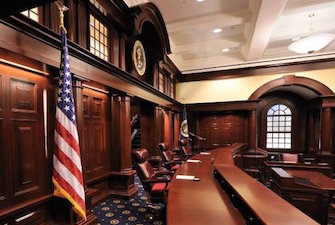 Several weeks ago, the United States Court of Appeals for the Federal Circuit issued a decision in Dynamic Drinkware v. National Graphics, which asked the Court to determine who has the burden with respect to whether a provisional patent application sufficiently supports a later-issued patent so as to become effective prior art as of the provisional filing date in an inter partes review.
Several weeks ago, the United States Court of Appeals for the Federal Circuit issued a decision in Dynamic Drinkware v. National Graphics, which asked the Court to determine who has the burden with respect to whether a provisional patent application sufficiently supports a later-issued patent so as to become effective prior art as of the provisional filing date in an inter partes review.
National Graphics owns U.S. Patent 6,635,196, which is directed to making molded plastic articles bearing a “lenticular” image. The ’196 patent issued on October 21, 2003, from an application filed on November 22, 2000. The ’196 patent claims the benefit of U.S. Provisional Application 60/211,112, filed on June 12, 2000.
Dynamic petitioned the PTO for inter partes review of the ’196 patent. In its petition, Dynamic argued that claims 1, 8, 12, and 14 of the ’196 patent were anticipated by U.S. Patent 7,153,555 (“Raymond”). The application for Raymond was filed on May 5, 2000, claiming the benefit of U.S. Provisional Application 60/182,490 (the “provisional application” or “Raymond provisional application”), filed on February 15, 2000. The PTO granted the petition in part, and instituted trial on claims 1 and 12.
The Board concluded that Dynamic failed to prove by a preponderance of the evidence that claims 1 and 12 were anticipated under § 102(e)(2) by Raymond. The Board first found that Dynamic failed to prove that the Raymond patent was entitled to the benefit of its earlier February 15, 2000 provisional filing date, and hence that it was a § 102(e) reference as of its provisional date. According to the Board, “[t]o be entitled to rely on the February 15, 2000 provisional filing date, [Dynamic] had to establish that it relies on subject matter from Raymond that is present in and supported by its provisional.” Ultimately, the Board found that Dynamic “failed to carry its burden of proof that Raymond’s effective date is earlier than May 5, 2000.” The Board then found that National Graphics reduced to practice its invention by March 28, 2000, before the May 5, 2000 filing date of the Raymond patent. Thus, the Board concluded that Dynamic failed to demonstrate by a preponderance of the evidence that claims 1 and 12 of the ’196 patent were anticipated by Raymond under § 102(e).
The Federal Circuit, in an opinion authored by Judge Linn, determined that the Board did not err in placing the burden on Dynamic, the petitioner in the inter partes review, to prove that the prior art Raymond patent was entitled to the filing date of its provisional application. Judge Linn pointed out that, in an IPR, the burden of persuasion is on the petitioner to prove “unpatentability by a preponderance of the evidence,” citing 35 U.S.C. § 316(e), and that burden never shifts to the patentee.
Dynamic also had the initial burden of production (which does shift), and it satisfied that burden by arguing that Raymond anticipated the asserted claims of the ’196 patent under § 102(e)(2). Once the burden of production shifted to National Graphics, it was argued that Raymond is not prior art because the asserted claims in the ’196 patent are entitled to the benefit of a earlier priority date. National Graphics produced evidence that the invention claimed in the ’196 patent was reduced to practice prior to the filing date of Raymond, and thus contended that the asserted claims were entitled to a date of invention prior to that of the Raymond patent.
As a result of the argument and evidence of actual reduction to practice, the burden of production returned to Dynamic to prove that either the invention was not actually reduced to practice as argued, or that the Raymond prior art was entitled to the benefit of a filing date prior to the date of National Graphics’ reduction to practice. Dynamic failed to carry its burden of proving that Raymond’s effective date was earlier than the date that the invention claimed in the ’196 patent was reduced to practice.
Regardless of the actual reduction to practice date, Judge Linn’s opinion went further. The Federal Circuit also pointed out that Dynamic failed to compare the claims of the Raymond patent to the disclosure in the Raymond provisional application. In fact, it is axiomatic that a reference patent is only entitled to claim the benefit of the filing date of its provisional application if the disclosure of the provisional application provides support for the claims in the reference patent in compliance with § 112, ¶ 1 [Ed. note: now 112(a)]. Thus, the Federal Circuit concluded that the Board’s finding that Dynamic failed to prove that the Raymond patent was entitled to the filing date of its provisional application was supported by substantial evidence.
Tags: CAFC, Federal Circuit, inter partes, Inter Partes Review, patent, patents




You share in the PLI Practice Center community, so we just ask that you keep things civil. Leave out the personal attacks. Do not use profanity, ethnic or racial slurs, or take shots at anyone's sexual orientation or religion. If you can't be nice, we reserve the right to remove your material and ban users who violate our Terms of Service.